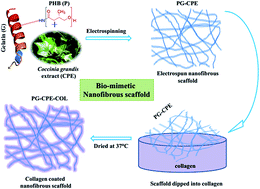Fabrication and characterization of a collagen coated electrospun poly(3-hydroxybutyric acid)–gelatin nanofibrous scaffold as a soft bio-mimetic material for skin tissue engineering applications
Abstract
Wound healing is a global health care problem. The use of a suitable dressing material by means of a nanofibrous scaffold with traditionally important medicine can help to repair the damaged skin tissue. An ideal wound dressing material should mimic the function of an extracellular matrix with its improved physiochemical, biological and antimicrobial properties. In this study, the significance features of a collagen coated electrospun poly(3-hydroxybutyric acid)–gelatin nanofibrous scaffold with a bioactive Coccinia grandis extract (CPE) meets the requirements for a wound dressing material. The nanofibrous scaffold with collagen has an attraction for fibroblast, which increases cell adhesion and proliferation. The fabricated nanofibrous scaffold with collagen was characterized physio-chemically using Fourier transform infrared (FTIR) spectroscopy, scanning electron microscopy (SEM), and it showed acceptable antibacterial property with both Gram positive and Gram negative bacteria. The thermal and in vitro stability of the nanofibrous scaffold was studied and it was found to have stability more than that required for a wound dressing material. The nanofibrous scaffold supports good swelling property with better porosity for oxygen permeability. The mechanical property of the nanofibrous scaffold showed a Young's modulus of 2.99 ± 0.16 MPa. The biocompatibility of the nanofibrous scaffold exhibits increased cell adhesion and proliferation of both NIH 3T3 fibroblast and human keratinocytes (HaCaT) cell line. The in vitro fluorescence staining of the nanofibrous matrix using Calcein AM and DAPI exhibits the cell material interaction of the collagen coated nanofibrous scaffold corresponding to increased cell adhesion and proliferation. This approach with a nanofibrous scaffold coated with collagen can be a promising tool in skin tissue engineering and can be useful as a wound dressing material in skin tissue engineering applications.

- This article is part of the themed collection: Editors Collection for RSC Advances - India

 Please wait while we load your content...
Please wait while we load your content...